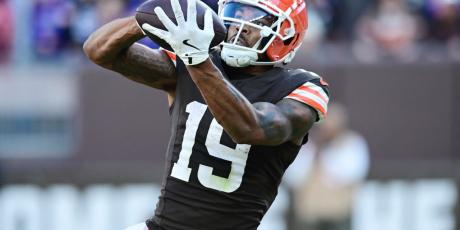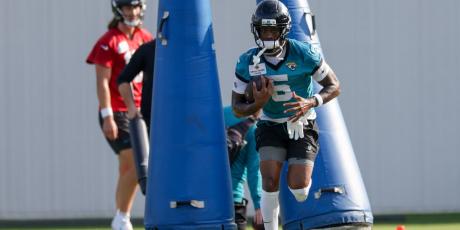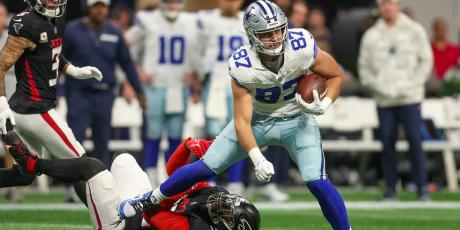Building a Player Portfolio for DRAFT Best-Ball Leagues

There is still over a month left before the NFL regular season officially kicks off and while many best-ball enthusiasts have been drafting since spring, there is still plenty of time to get your fair share of DRAFT drafts in (see what I did there?). For those new to best-ball leagues, the concept is pretty simple—you draft 18 players and there is no roster management. DRAFT is half-PPR scoring and starts 1 QB, 2 RBs, 3 WRs, 1 TE, and 1 RB/WR/TE. Each week, your lineup is automatically optimized with the top scorers at each position. For the best practices on how many players to draft at each position, this is what worked in 2018. While picking the top fantasy performers is obviously going to lead to league titles, playing a high number of best-ball leagues forces owners to consider strategies for concepts that traditional redraft players may not be familiar with, namely player exposure. The following will go over that concept.
More DRAFT strategy articles: Managing Bankroll | What Worked in 2018
How Many Leagues Should You Play?
Since there is no in-season management in best-ball leagues, teams are typically subject to a great deal of variance—an injury to a top player is nearly impossible to rebound from since you can’t replace him via the waiver wire or a trade. Because of this, owners should try to play as many leagues as possible. More leagues mean getting exposure to a greater number of players while also getting a return on your money that closely reflects your skill level. With the ability to sign up for slow drafts, owners can draft in multiple leagues at once with little stress and still reach reasonably high volume in a month’s time. In order to at least approach a portfolio where variance starts to smooth out, my suggested minimum number of leagues is 30.
Statistically speaking, when a random sample approaches 30, the sample of “scores” should begin to approach a normal distribution. This means that around 30 drafts, you should begin to see a roughly even number of leagues that you are in from each draft slot. Naturally, a smooth distribution of picks from each slot should mean that you at least had a chance to draft most players, especially in the early rounds where there is little variance in ADP. As you get to the mid and late rounds, playing in at least 30 leagues means that you should have seen players with big swings in their respective ADPs available across that entire range—put another way, you should have had a chance to get almost every player at a value. Now that we have a target number of leagues, the logical next question is how often you should draft each player.
What is the Maximum Exposure You Should Have to a Single Player?
In a normal redraft league, we simply want our guys, even if it means reaching. In best-ball, zeroing in on any single player and targeting them in every draft can spell disaster—remember we have no in-season management to reconcile our lapses in judgment. A general rule of thumb to keep in mind is the more expensive a player, the less exposure you should have. Here are some rough rules of thumb, which of course can be adjusted to each player’s risk tolerance:
15%–25% in Rounds 1–3 - Anything above 20% is probably on the high end for players in the early rounds. The downside of whiffing on a top pick is simply too devastating to a team to hope for a top-three finish without hitting on an absolute gem in the middle or late rounds. Additionally, math will almost never let this happen since ADPs are generally so static in the first couple of rounds. If you are in 30 leagues, it will be almost impossible to have more than four or five shares of a player with a first-round ADP.
- 20%-35% in Rounds 4–8 - As we get to the middle rounds, the parameters on exposure and rounds starts to get a little loose. More conservative players might wait until the double-digit rounds to get loose with their player exposure while other owners are willing to take more risks as early as Round 6 or 7. Regardless, we are still somewhat handcuffed by ADP since there is still not a ton of variance in price at this point in the draft. This is also the portion of the draft where whiffing on some of your favorite players isn’t a death sentence. My personal preference in this part of the draft is to look for the best values, or players that have fallen the furthest—if I can have a portfolio full of players taken well beyond their ADPs, I probably stand to make some good money, even if I don’t personally project those players for big years.
- 30%-100% in Round 9-18 - Especially at the very end of drafts, it’s not uncommon for some of the top best-ball owners to target the same players almost every time. My personal threshold is somewhere in the 65%-75% range for players taken in the last two or three rounds but the point here is that going big on players late in drafts is how you can separate yourself from the pack and come away with a massive return. Risk-averse owners will keep their exposure under 50% even for the cheapest players but ultimately it’s a matter of personal preference. The later we get into a draft, the less of an impact a bad pick will have on or team. We still want some exposure to as many “diamonds in the rough” as possible.
The Bottom Line
Unlike traditional redraft leagues, best-ball requires thinking about our strategy across multiple teams rather than focusing on a single draft. Two major aspects of that strategy are managing league volume and player shares. The guidelines laid out in this article should give owners that have never even played in a best-ball league a good—and profitable—place to start. Luckily for us, the DRAFT app tracks how many leagues you are in and what percent of leagues you have each player, doing the heavy lifting for us.




















